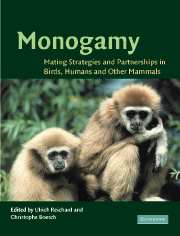Book contents
- Frontmatter
- Contents
- List of contributors
- Acknowledgements
- Introduction
- PART I Evolution of social monogamy
- PART II Reproductive strategies of socially monogamous males and females
- PART III Reproductive strategies of human and non-human primates
- CHAPTER 11 Ecological and social complexities in human monogamy
- CHAPTER 12 Social monogamy in a human society: marriage and reproductive success among the Dogon
- CHAPTER 13 Social monogamy in gibbons: the male perspective
- CHAPTER 14 Pair living and mating strategies in the fat-tailed dwarf lemur (Cheirogaleus medius)
- CHAPTER 15 Social monogamy and its variations in callitrichids: do these relate to the costs of infant care?
- CHAPTER 16 Monogamy in New World primates: what can patterns of olfactory communication tell us?
- Index
CHAPTER 11 - Ecological and social complexities in human monogamy
Published online by Cambridge University Press: 05 July 2014
- Frontmatter
- Contents
- List of contributors
- Acknowledgements
- Introduction
- PART I Evolution of social monogamy
- PART II Reproductive strategies of socially monogamous males and females
- PART III Reproductive strategies of human and non-human primates
- CHAPTER 11 Ecological and social complexities in human monogamy
- CHAPTER 12 Social monogamy in a human society: marriage and reproductive success among the Dogon
- CHAPTER 13 Social monogamy in gibbons: the male perspective
- CHAPTER 14 Pair living and mating strategies in the fat-tailed dwarf lemur (Cheirogaleus medius)
- CHAPTER 15 Social monogamy and its variations in callitrichids: do these relate to the costs of infant care?
- CHAPTER 16 Monogamy in New World primates: what can patterns of olfactory communication tell us?
- Index
Summary
INTRODUCTION
The term ‘monogamy’ can mean a number of things. Genetic monogamy is unlikely unless it raises (male) reproductive success enough to compensate for the loss of reproductive success (RS) that would have come from additional mating efforts. We expect to see male parental polygyny under these conditions: (i) whenever a female can raise offspring successfully alone, and (ii) when male care that sufficiently enhances offspring survivorship and competitive success can be ‘generalizable’ – no more expensive for several offspring than for one (e.g., a nest or den that can serve several clutches or litters). Consider red-winged blackbirds, in which males watch and warn at the approach of potential predators; a male can do this effectively for several nests, at the same cost as for one.
For a system to be genetically monogamous, then, it is important that the male care be a non-generalizable, true parental investment such as feeding (Trivers, 1974), rather than a more general parental effort (such as a nesting den, which can function for numerous offspring: Low, 1978). Other routes to monogamy also exist: in some species, both mate guarding (that eliminates other mating chances), and the ecology of female dispersion may make males unable to monopolize more than one female, and therefore lead to monogamy (Jarman, 1974; Emlen & Oring, 1977). But when females are controllable and/or must be guarded constantly, or when male effort can be generalized, we see either open polygyny or social monogamy without true genetic monogamy.
- Type
- Chapter
- Information
- MonogamyMating Strategies and Partnerships in Birds, Humans and Other Mammals, pp. 161 - 176Publisher: Cambridge University PressPrint publication year: 2003
- 26
- Cited by



